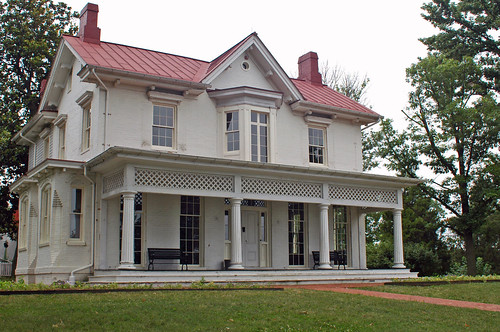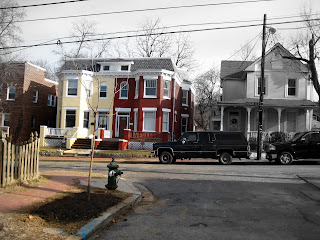It happened the following Saturday on an already warm and muggy April morning. I drove my truck to Home Depot in Oxon Hill, Maryland -- my quasi home away from home.
His truck was there, a dingy, light-brown Ford F-150. It looked beat up, weathered, but under her hood sported a souped up V-8 engine that could pull a 6,000 lb camper or a 20 foot sailboat.
And hanging on the door was a sign that immediately caught my eye: “Triple T Home Repairs”. I didn’t hesitate - the sign enticed me to
wait a minute. I picked up my cell and started dialing even before I finished reading the sign.
wait a minute. I picked up my cell and started dialing even before I finished reading the sign.
A fellow by the name of Jeff answered the phone by the second ring.
“Let’s meet inside the customer service desk.”
I agreed and headed inside.
At 5’ 8” Jeff Bishop was stocky, carrying a few extra pounds but not overweight.
He had wide shoulders, thick legs and even a bigger grin.
Jeff carried a cheery demeanor and I immediately felt that he was trustworthy. But I knew I had to be careful. I felt the same with Jerry, with Jimmy, with Monty and now Bobby.
“What’s up big doc,” he said, giving my hand a firm shake. “My name’s Jeff. What can I do for you today?”
“Nice to meet you Jeff. Name’s Chito. “
“What have you been up to?” His smile seemed genuine and warm.
“Just staying busy. You know we’re busting our backsides here, fixin’ my damn house – it’s like pouring money down the drain. Can you help?”
I asked if he was willing to install a surround bath and do some laminate flooring work. He told me that he would be glad to take a look at it.
“There’s absolutely nothing I wouldn’t tackle—except carpentry,” he said. “And I’m willing to do just about anything even clean a shitter, if the price is right.”
“I also do some electric but I won’t change out power panels,” he added. “Leave that for the big boyz. I want to live long enough to see my baby finish school, get married and make me a proud granddaddy someday.”
Jeff by trade was a plumber and professionally schooled as a pipefitter journeyman, welder and foreman.
He was licensed for those skillsets, but nevertheless, he considered himself a jack-of-all –trades, and at the end of the day cared mostly about the bottom line. He would even haul a load of trash as long as there was a big healthy stack of greenbacks waiting for him in the end.
Jeff Bishop, the sunny-tempered, pleasant-faced former crack addict whose plump mien always lights up with a smile, is a pipe fitter by trade.
Despite his trade, he would always strut in style. On his fingers, Jeff wore six gold, diamond-studded rings. On his neck he wore a gold necklace with a heavy cross pendant. Each piece of jewelry represents the eight years that Jeff had been drug free.
Never daunted by squalid, filthy environs, he religiously lives by his motto: nothing is too heavy or too messy for him to deal with. His job may not rank too high in prestige, but his skills are undeniably in high demand and he has no qualms about charging an extremely high premium for it.
He is indiscriminate about location and takes on plumbing jobs in every nook and cranny of the city, and when it gets to the sewer business, the mess is unbelievable. Yet, he is able to take in all in his stride, after all, what matter, if in the end it brought him the green bucks.
Jeff has volumes of such squalid stories in his memory bank he would relate to create a diversion in the monotony of the tedious renovations. He told grimy, sordid stories of working on the condos on Danbury St SW, near South Capitol Street where sewer lines of the buildings were never connected to the city's sewer lines.
And so it happened that for a good 20 years, the waste from the bathrooms ran into the ground and eventually seeped through the basement walls, oftentimes creating visible pools of sewage. Homeowners had to install a sump pump that worked 24 hours a day to pump raw sewage out of the basement and out onto the back alley. The ensuing revolting situation defied description, with toilets stopping up and drinking water becoming contaminated. Eventually the city gave up and demolished the buildings.
Jeff spoke of stories that the city had worked out a deal with Centex Homes, an established builder known for constructing upper middle class town houses in the past. It would a first for Centex Homes to build housing in the city and it would not be long before they realized this was a different kettle of fish.
I was going to make Jeff responsible for unclogging my drains, for installing two new bathrooms and for replacing faulty plumbing. Intuitively I knew that this would work.
Jeff and I made a commitment to meet at Lebaum St. that afternoon. He showed up promptly in his beat up Ford F-150. From the sidewalk he gave the house one good look over as if he could sum it all up from just out in the street.
Then Jeff coolly strolled in. He carried an easy gait, head held high, he squeezed his wide shoulders through the front door and made his presence known like a big jobsite foreman would. He looked around and saw the rugged team of men working aimlessly in the house and didn’t pipe a word.
He eyed them suspiciously and they stared back like he was some city inspector or tax collector or even worse the drug king from around the corner snooping on their turf.
As he toured up and down, every nook and cranny, he shook his head in utter disbelief. “Pitiful and disgusting” were the only words in his tongue.
Jeff was ripping the place apart as if this house could be condemned right then and there. I was alarmed but internally satisfied. This was exactly the kick ass, take names type of guy I was looking for – exactly what I needed.
Jeff inspected the whole entire house and noted the sloppy paint job and the basement with the unleveled walls.
Then down in the basement, inside an empty room at a far corner, the doors shut tight, Jeff came right up to me.
“Man, who you got doing the work—a bunch of drunken, sloppy, good-for-nothing crackheads?”
“I guess. They’re the best I got though.”
“Where did you pick these ghetto rats at; down the street on King Ave? I mean I got hoes that can skim, sand and paint better than that. My girls will put these guys to shame anytime of the day or night.”
Sinzinger, Kathryn and Abeyta, Oscar, "Ward 8's Public Cesspool", The Common Denominator, Dec 4, 2000
|










